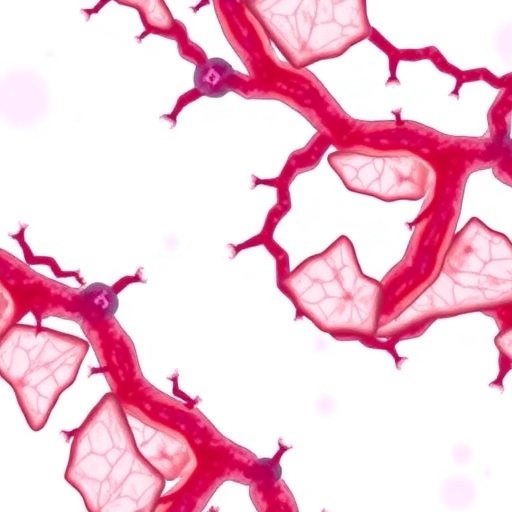
In the realm of biomedical science, one of the most pressing challenges researchers face is understanding and mitigating the effects of hypoxia on cellular functions, particularly within the cardiovascular system. A recent study led by researchers including Hei, Zhang, and Yang sheds light on the protective role of Liver Kinase B1 (LKB1) in counteracting hypoxia-induced dysfunction in pulmonary arterial endothelial cells. This groundbreaking research delineates the interplay between LKB1 and the AMP-activated protein kinase (AMPK) pathway, which are vital for cellular metabolism and survival under unfavorable conditions.
Hypoxia, a condition characterized by inadequate oxygen supply, has been shown to disrupt various cellular processes, especially within endothelial cells lining the pulmonary arteries. These cells play a pivotal role in maintaining vascular homeostasis and ensuring proper blood flow throughout the body. When hypoxia strikes, it initiates a cascade of pathological changes, ultimately leading to impairments in endothelial function, vascular remodeling, and potentially severe cardiovascular diseases. The findings from this study offer crucial insights into the mechanisms by which LKB1 can mitigate these harmful effects.
Liver Kinase B1 is a serine/threonine kinase known for its role as a crucial regulator of metabolic pathways. Its activation leads to numerous downstream effects, including the enhancement of autophagy, modulation of cell growth, and fortification of cell survival mechanisms. The study highlights that LKB1 plays a significant role in protecting pulmonary arterial endothelial cells from the deleterious effects of hypoxia. By initiating a protective cellular response, LKB1 is revealed to act as a guardian against the stress induced by oxygen deprivation.
Central to the study is the AMP-activated protein kinase (AMPK), a key energy sensor in cells that regulates various metabolic processes. When energy levels are low, AMPK activation helps restore cellular energy balance by promoting catabolic pathways while inhibiting anabolic processes. The interaction between LKB1 and AMPK is particularly crucial in the context of hypoxia, as LKB1 phosphorylates and activates AMPK, thereby leading to enhanced cellular protection against the hypoxic stress.
The research demonstrates that activation of the AMPK pathway by LKB1 significantly enhances the survival potential of pulmonary arterial endothelial cells during hypoxic conditions. This suggests that Therapeutic strategies aimed at enhancing LKB1 or AMPK activity could hold promise in preventing and treating hypoxia-induced vascular dysfunction. The implications of these findings extend beyond pulmonary endothelial cells, as the LKB1-AMPK axis may influence vascular health in various tissues and organ systems.
Interestingly, the study also employed various experimental models to validate the protective role of LKB1. Using in vitro and in vivo approaches, the researchers observed enhanced endothelial cell viability and reduced apoptotic markers in the presence of hypoxia when LKB1 activation was promoted. These findings were corroborated with biochemical assays and microscopy techniques, which provided strong evidence for the protective mechanisms at play.
The pathophysiological significance of these findings cannot be overstated. With cardiovascular diseases claiming millions of lives each year, understanding the molecular mechanisms that govern endothelial dysfunction could lead to the development of novel therapeutic interventions. This study lays a foundational framework for further investigations into how pharmacological agents or lifestyle modifications that stimulate LKB1 or AMPK might aide in the prevention of hypoxia-related vascular disorders.
Moreover, the research invites a closer examination of the pharmacological landscapes surrounding AMPK activators, such as metformin and other compounds currently under investigation. Not only does this study bolster the case for AMPK as a therapeutic target, but it also opens doors to understanding the combined effects of different pathways involved in endothelial cell survival and function.
Additionally, the authors encourage future studies to explore the multifunctional role of LKB1 beyond AMPK activation. LKB1 has been implicated in various signaling pathways, including those involved in cell polarity, migration, and stress response. Therefore, a comprehensive understanding of LKB1’s role in hypoxia could reveal new dimensions of endothelial cell biology and potential therapeutic targets for various cardiovascular diseases.
Future research should also evaluate the translational aspects of these findings. How can we translate the knowledge gained from this study into clinical practice? The optimization of LKB1 activation or AMPK modulation could be harnessed as a treatment strategy for patients suffering from oxygen-related ailments, including chronic obstructive pulmonary disease (COPD) and pulmonary hypertension.
The study calls for a thorough investigation of the pharmacokinetics and pharmacodynamics of potential LKB1 activators in human populations. A multidimensional approach that includes genetic, biochemical, and clinical evaluations will be crucial in establishing the efficacy and safety of such therapies.
Furthermore, as research continues to evolve, the importance of precision medicine cannot be overlooked. Personalized treatment strategies based on individual genetic backgrounds and risk factors could enhance the efficacy of therapies targeting the LKB1-AMPK signaling pathway. Hence, understanding the genetic predisposition of patients to hypoxic conditions may lead to bespoke therapeutic regimens.
In conclusion, the work carried out by Hei, Zhang, and Yang provides a significant advance in our understanding of hypoxia-induced pulmonary arterial endothelial cell dysfunction. By elucidating the protective role of LKB1 through the AMPK pathway, they have opened avenues for new therapeutic strategies that could mitigate the devastating effects of hypoxic conditions on the cardiovascular system. As we continue to unravel the complexities of endothelial cell biology, this research serves as both a cornerstone and a beacon of hope for future advancements in cardiovascular health.
Subject of Research: The protective role of Liver Kinase B1 in hypoxia-induced pulmonary arterial endothelial cell dysfunction.
Article Title: Correction: Liver Kinase B1 Protects Against Hypoxia-Induced Pulmonary Arterial Endothelial Cell Dysfunction via the AMP-Activated Protein Kinase Pathway.
Article References: Hei, B., Zhang, A., Yang, M. et al. Correction: Liver Kinase B1 Protects Against Hypoxia-Induced Pulmonary Arterial Endothelial Cell Dysfunction via the AMP-Activated Protein Kinase Pathway. Biochem Genet (2025). https://doi.org/10.1007/s10528-025-11196-y
Image Credits: AI Generated
DOI:
Keywords: LKB1, AMPK, Hypoxia, Pulmonary Endothelial Cells, Cardiovascular Diseases, Cell Survival, Metabolic Pathways, Therapeutic Strategies.
Tags: AMPK pathway in cardiovascular healthautophagy enhancement in endothelial cellscardiovascular disease and hypoxiaeffects of hypoxia on vascular homeostasisendothelial cell protection from hypoxiaimplications of LKB1 in metabolic pathwaysLiver Kinase B1 role in hypoxiamechanisms of hypoxia-induced cellular damagemetabolic regulation by LKB1pulmonary arterial endothelial dysfunctionresearch on endothelial cell survivalserine threonine kinase functions




